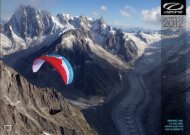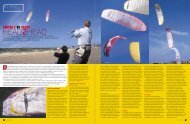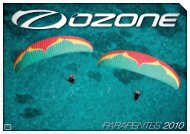PILOT'S MANUAL MANUEL DE VOL - Ozone
PILOT'S MANUAL MANUEL DE VOL - Ozone
PILOT'S MANUAL MANUEL DE VOL - Ozone
You also want an ePaper? Increase the reach of your titles
YUMPU automatically turns print PDFs into web optimized ePapers that Google loves.
SPIRAL DIVE<br />
When you turn a series of tightening 360s the paraglider will enter a spiral - a<br />
highly banked turn with rapid height loss. The longer you hold the inside brake<br />
on, the faster the turn becomes. Safe descent rates of 8metres/second (500<br />
ft/min approx.) are possible in a spiral dive, but at these high speeds and G-<br />
forces it is easy to become disorientated, so you must pay particular attention to<br />
altitude.<br />
To exit the spiral dive, slowly release the inside brake and apply a small amount<br />
of outside brake. As the glider begins to decelerate it is important to allow it to<br />
continue in its turn until enough energy has been lost for it to return to level flight<br />
without excessive surging.<br />
Spiral dives with sink rates over 8 m/s are possible, but should be avoided. They<br />
are dangerous and put unnecessary strain on the glider.<br />
IMPORTANT: Spiral dives cause disorientation and need time and hight to<br />
recover. Do not perform this manoeuvre near the ground.<br />
<strong>DE</strong>EP STALL<br />
Your glider is designed to exit immediately from any deep-stall configuration within<br />
four seconds of the brakes or B-line stall being released. If you find yourself in<br />
a deep-stall situation (loss of forward speed, low internal wing pressure) ensure<br />
your brakes are up. If your glider does not return to normal flight, you should gently<br />
push the A-risers forward until the glider surges slightly and normal flight is<br />
resumed.<br />
<strong>DE</strong>FLATIONS<br />
Due to the flexible form of a paraglider, turbulence may cause a portion of the<br />
wing suddenly to collapse.<br />
An asymmetrical collapse can be easily controlled by weight shifting to the open<br />
side and applying the minimum amount of brake required to control your direction.<br />
It is important not to brake too much, the glider must retain enough speed<br />
to continue to fly and does not inadvertently enter a spin. A long, smooth progressive<br />
pump on the deflated side will assist reinflation. (Flapping your arms<br />
uncontrollably will not help).<br />
A symmetrical collapse should reinflate quickly without pilot input, however 15 to<br />
20cm of brake applied symmetrically will speed the process. If your glider has a<br />
collapse in accelerated flight you must immediately release the stirrup to slow<br />
down to trim speed.<br />
Active flying will virtually eliminate any tendency to collapse.<br />
14
















